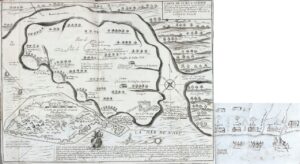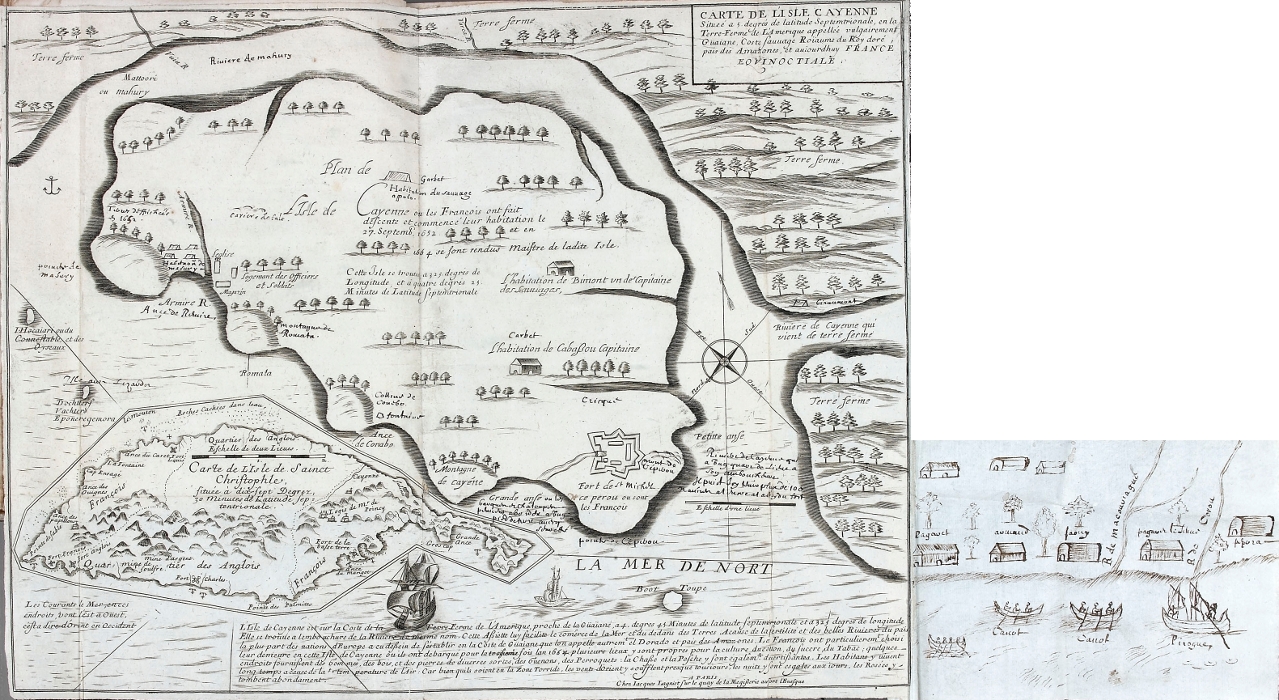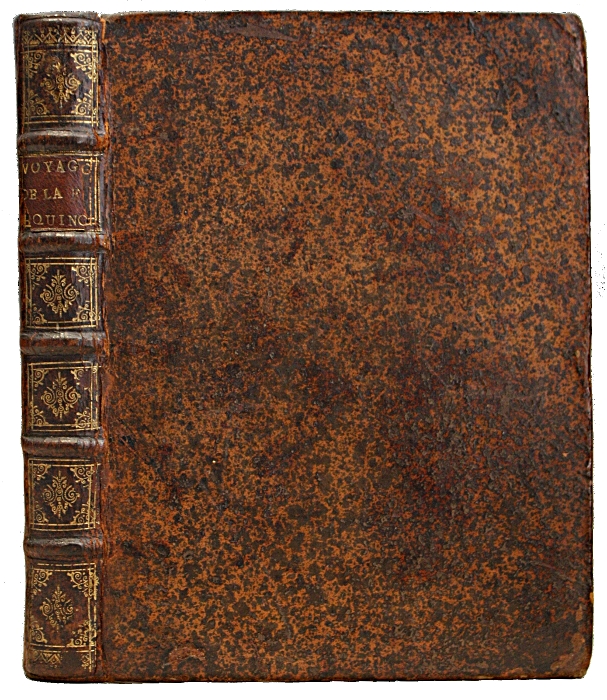Paris, François Clouzier, 1664.
4to [230 x 173 mm] (12) ll. (title, dedication, foreword, table, privilege), 432 pp., 1 folding map with a flap.
Bound in contemporary full brown granite-like calf, spine ribbed and decorated, red morocco lettering-piece with little loss, mottled edge. Joints lightly rubbed.
Rare first edition of the account of the attempt of the establishment of a colony in Cayenne undertaken by the French in 1652.
It is one of the earliest works about French Guiana.
Streit 1974 ; Leclerc 2236 ; Brunet, I, 941 ; Chadenat 18 ; Sabin 5269 ; Picot, Catalogue Rothschild, 1993 ; Rahir, La Bibliothèque de l’amateur, 323 ; Bulletin de la librairie Morgand et Fatout, 9094 ; Huth 167 ; Field, An Essay towards an Indian Bibliography, 127 ; Rich 334 ; Arents 287.
« Very rare » (Morgand et Fatout).
« No relation throws as much light as Biet’s one on the natives of Guiana; he described them in their primitive simplicity. The vocabulary of their language is composed with care, and it is preceded with useful remarks concerning the language of Galibis people common to all the inhabitants of the coast from the amazons’ river. » Biblioth. Des Voyages ». (Chadenat).
« An account of the conquest of French Guinea. The country and nations are very accurately described». (Bohn, Catalogue of a very select collection of books, 562).
“The first book contains an account of Cayenne; the second the history of the first fifteen years; and the third of the natives, who are very accurately described. A vocabulary of their language is added.” (Pinkerton).
Antoine Biet, born about 1620 in the diocese of Senlis, is a French missionary who embarked for Cayenne in 1652 with a 600 settlers troop sent to America by a company which owned the colony. The venture had a terrible ending, and Biet had to devote himself to his companions’ relief, as they were the victims of diseases and poverty. He came back to France after a fifteen months stay in America and started to write the relation of his travel.
The first two books give a detailed account of the preparation of the expedition and of the settlement of the colony in Cayenne, which ends in a big failure as hunger and diseases quickly decimate the settlers.
The conflicts with the natives are also described in this second part. The third book is a detailed study of the island and its population.
The Dictionnaire de la Langue des Sauvages Galibis given by Biet, which fills pages 399 to 432, is of the highest interest.
The Galibis Indians live dispersed among Guiana, Surinam, Guyana, Brazil and Venezuela.
« Father de Marivault was appointed director of the colony in the country: the two others were Messrs de Vertaumon and Isambert. In accordance with the colony’s demand, Father de Marivault took care of things spiritual, helped by 4 other clergymen, Messrs Chasteau, Colsonet, Aleaume and Biet. »
A very precious copy which belonged to Father Jacques Aleaume, one of the 4 clergymen who took part in the expedition to Guiana, and the only one who survived the adventure with the book’s author, Antoine Biet.
Biet mentions several times the name of his colleague during his account:
-p.4: « Le sieur Abbé de l’Isle de Marivault associa six Ecclesiastiques avec lui, deux desquels manquèrent de courage après sa mort, les autres quatre ont passé dans le pays, à savoir les sieurs Chasteau, Colsonet, Aleaume et moi ».
-p.26 : « On mit dans chaque vaisseau deux Ecclesiastiques, pour avoir soin du spirituel ; j’étais dans l’Admiral avec Monsieur Chasteau, & dans le saint Pierre étaient Messieurs Colsonet & Aleaume ».
-p.129: « Le sieur de Vertaumon Gouverneur du Fort commence à faire paraître par ses intrigues qu’il voulait se rendre absolu & indépendant des Seigneurs de la Compagnie, qui étaient dans le pays […]. Il ne voulait pas que l’Ecclesiastique que je lui avais laissé, & qu’il m’avait demandé avec instance, fut dépendant de moi, ni de qui que ce fut. La place que je tenais dans la Colonie faisait que tous les Ecclesiastiques dépendaient entièrement de moi. Je lui avais donné le sieur Aleaume, très homme de bien, & très docte, en qualité de Chappelain, pour assister dans le fort la Garnison, & administrer les Sacrements aux malades seulement ».
-p.140: On February 5th 1653, a peace treaty written by Biet is signed by various Lords of the Colony; within appears the following article: « Ledit sieur Vertaumon se charge de fournir des vivres de ceux qu’il a, & qu’il aura des Sauvages & de la Compagnie, au sieur Aleaume Chappelain du fort & à son Clerc, … ».
-p. 191 : In the passage relating the « fuite honteuse du sieur de Vertaumon & de tous ses adherans dans la Barque, après avoir pillé le fort », Biet informs us of the way Jacques Aléaume left Guiana, on April 10th 1953 : « Le 9e jour d’Avril […], le sieur de Vertaumon faisait transporter dans la barque le meilleur qui appartenait à la Compagnie […]. Il débaucha Monsieur Aléaume Chapelain du fort, à qui il fit emporter les ornements nécessaires pour célébrer la Sainte Messe […]. Le plus grand pirate & forban de la mer n’aurait pas agi de la sorte ».
Among the 5 clergymen gone on this expedition to Guiana, Fathers Biet and Aleaume were the only ones to survive the difficult life conditions of the colony.
Father Aléaume was in a way saved from famine, which was decimating the colony, thanks to his fort’s chaplain position because Mr de Vertaumon who was running this fort had taken control of food, and was keeping the main part of it for the men working for him.
Besides, an old document told us that Jacques Aléaume was the priest of the church Saint-Paul of Orleans in 1665.
The present copy is grangerized. Actually Jacques Aléaume, its original owner, inserted at the time a detailed map of the colony in the volume, entitled Carte de l’Isle Cayenne située à 5 degrés de latitude Septentrionale, en la Terre-Ferme de l’Amérique appelée vulgairement Güaiane, Coste sauvage Roïaume du Roy doré, pais des Amazones et aujourd’hui France Equinoctiale. Paris, chez Jacques Lagniet, s.d. (1664-1672).
This rare map is recorded in the Inventaire du fonds français, graveurs du XVIIe siècle. (Bibliothèque nationale, Département des estampes ; [réd.] par Roger-Armand Weigert,… – Paris : Bibliothèque nationale, 1973) sous le n° 421 (p.124).
The present copy is of the highest interest because Jacques Aléaume, who took part in the 1652 expedition, inserted in his copy a map of the colony engraved by Lagniet, and he also added on it many handwritten information.
He indicates with his pen: the « pointe de Mahury », the « Rivière de Mahury », the « tribus difficiles en 1652 », the « Anse de Rémire », « l’Ile aux lézards », the « Montagne de Romata », the « crique », the « Colline de Conabo », the « fontaine », the « Pointe de Ceperou », the « Mont de Ceperou », the « Fort de Saint Michel Ceperou », …
Aléaume also drew various habitations on the map, such as “carbets”, the “Habitations de Mahury”, “l’Habitation du sauvage Appoto”, the one of “Biraumont”…
He gives very precise details concerning some parts of the map: « Grande anse où les barques ou chaloupes peuvent aborder… », « Rivière de Cayenne qui a … à son embouchure » …
This map is especially interesting because Aléaume added to it a 12 x 16 cm paper portion on which he drew a part of Cayenne which is not represented on the printed map, situated on the west side of the fort where he lived. Aléaume represented on this document the boats at the colony’s disposal (boats, pirogues), the rivers of Corou and Macouriague, and the houses of some savages, including the one of Pepora, drawn on the banks of the river of Corou.
An exceptional copy of this account of the terrible mission to Cayenne undertaken in 1652 by the French, which belonged to one of the two clergymen who survived the disaster, and who grangerized it with a map of Cayenne covered with his detailed handwritten notes.
Provenance: handwritten ex libris of Jacques Aliaume and ex libris with arms of Henry Somerset, second duc de Beaufort (1684-1711) on the paste-down.
ABPC lists only one copy of the present work in a contemporary binding without any restoration that appeared on the market since 1975.



